Causal Mapping
Causal maps (or causal diagrams) can help to illustrate and understand the interrelationships between environment, behavior, body, genes, brains and other factors in the evolution and development of individuals, populations and social-ecological systems. With their help, we can examine how different conditions and traits interact and change each other over time.
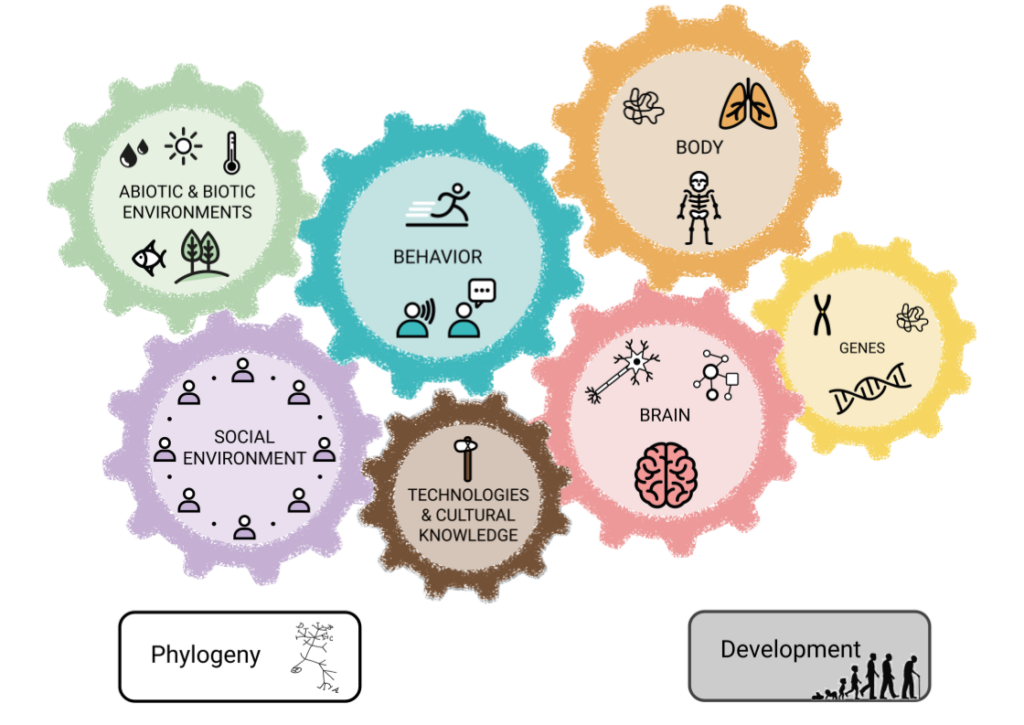
In causal diagrams, traits, conditions, or other variables and factors are linked by arrows that indicate a kind of causal relationship –
X leads to, changes, or influences Y.

These cause-and-effect relationships can be of different types. The specific nature of a cause-and-effect relationship can be stated if it is known or suspected, or it can remain general when the aim is to explore, discuss or reflect on it. For example, “is consumed by” is a more or less specific causal relationship in a diagram of a food web in an ecosystem.
When two factors influence each other, or when three or more factors are linked by causal relationships, it becomes more and more difficult to predict the consequences of these interactions – we call these complex causal interactions.
Complex systems are characterized by such complex causal relationships. We find them in many areas, e.g. in biology, psychology, planetary systems, ecology, and society.
Feedback Loops
Among the interactions in complex systems, we often find so-called feedback loops. In feedback loops, there is not only a relationship from cause to effect, but the effect itself impacts the cause. This can result in different patterns we find in nature and society.
Positive feedback loops are processes that reinforce themselves – the more of something there is, the more of it is generated, or the less of something there is, the less is produced. An example is exponential growth of a population.
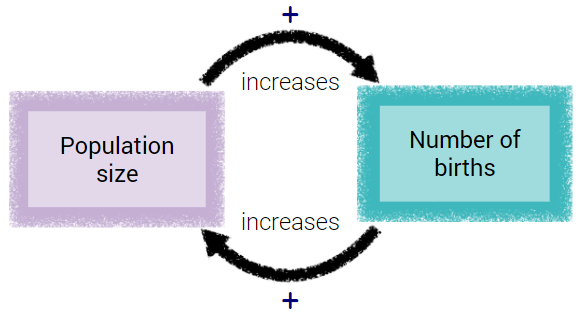
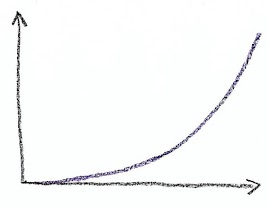

Negative feedback loops are processes that dampen themselves – the more of something there is, the less of it is produced, or vice versa. An example is the relationship between predator and prey populations. Negative feedback loops cause systems, e.g. living organisms and ecosystems, to regulate themselves (without a central leader or decision-maker). Many regulation processes of our body are a result of such negative feedback loops.
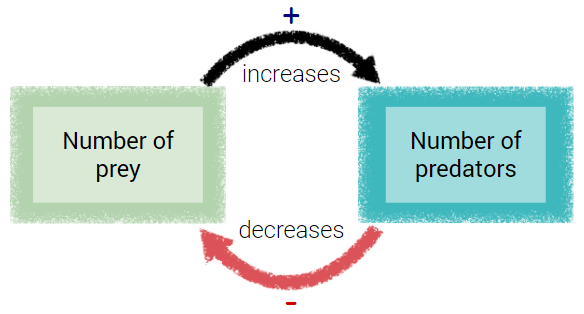

Importantly, the words “positive” and “negative” have nothing to do with whether a feedback is “good” or “bad”, but merely describes the dynamics:
Positive means “more leads to more” or “less leads to less”;
Negative means “more leads to less” or “less leads to more”;
When positive feedback reinforces something we consider to be “bad,” we often talk about a “vicious circle” or a “downward spiral.”
Conversely, if positive feedback reinforces something that we consider “good,” people talk about a “virtuous circle” or “upward spiral”.
System archetypes
Complex systems seem to be characterized by recurring structures and dynamics through the interaction of various feedback loops and delays.
The concept of system archetypes describes some of these typical system structures and dynamics.
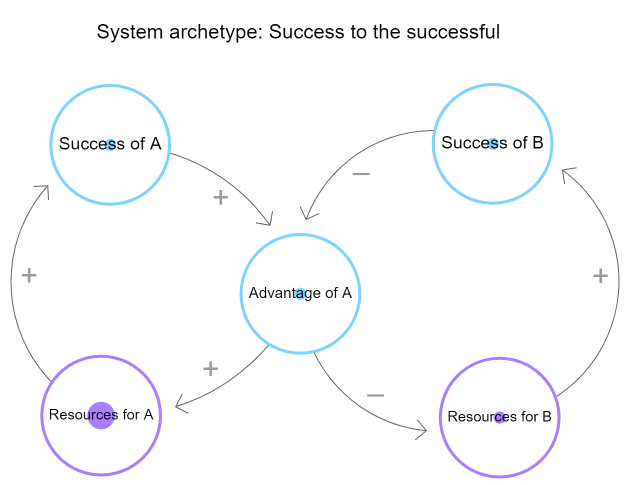
System archetypes
A collection of causal maps for system archetypes, made with Loopy
Causal maps for understanding social-ecological systems
Particularly the development of our global social-ecological system is characterized by feedback loops that arise from the interplay between environmental conditions, our technologies and institutions, the behavior of individuals, and the relationships between individuals. Many of the changes in the world today are the result of positive feedback. Some of them are moving in a direction that we consider “good” – they help us progress towards our common goals. Others are moving in a direction we deem “bad” – they present challenges in achieving our common goals.
How do our social and natural environments, our technologies and institutions, our behaviors and perceptions affect each other?
Causal diagrams allow teachers and students to reflect on concrete relationships between these factors in particular contexts, and to discuss ways in which we can consciously influence the evolution of these factors, individually and as a community.
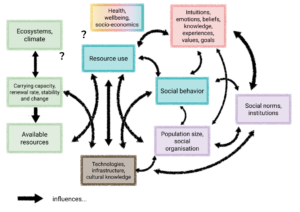
Connecting Past, Present, and Future
A collection of materials for connecting past human evolution to the present and the future. Students explore global trends and relationships between human behavior, technologies, social organization, environment, and well-being.

Causal mapping pieces for causal relationships in the present and future
Materials for creating a causal map on the relationships between human behaviors, technologies, institutions, social and natural environments
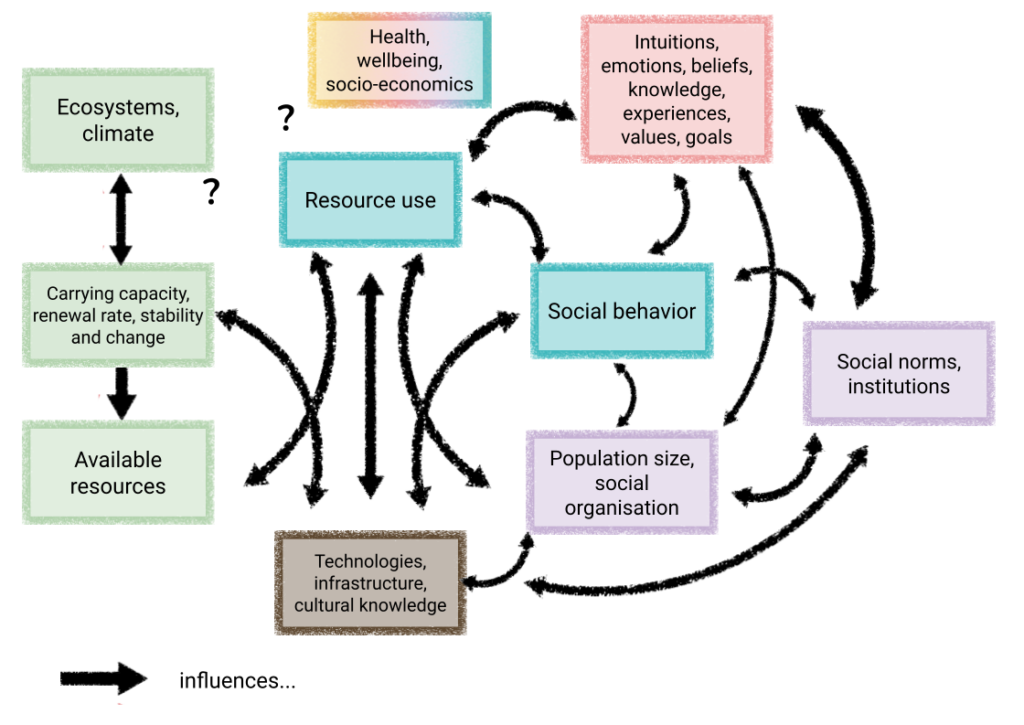
Causal maps for evolution education
“Natural selection” is a particular type of causal relationship in which a condition “selects” a trait, that is, leads to an increase in the frequency of the trait in the population.
Different selection and inheritance mechanisms may be at play depending on the trait. For example, genes can become more common in a population because some individuals have more surviving offspring than others, and they pass on their genes through biological reproduction. Behaviors can become more common in a population because many are motivated to do the behavior, and it can get transmitted to others through imitation or teaching.
This way natural selection leads to changes of trait frequencies in populations.
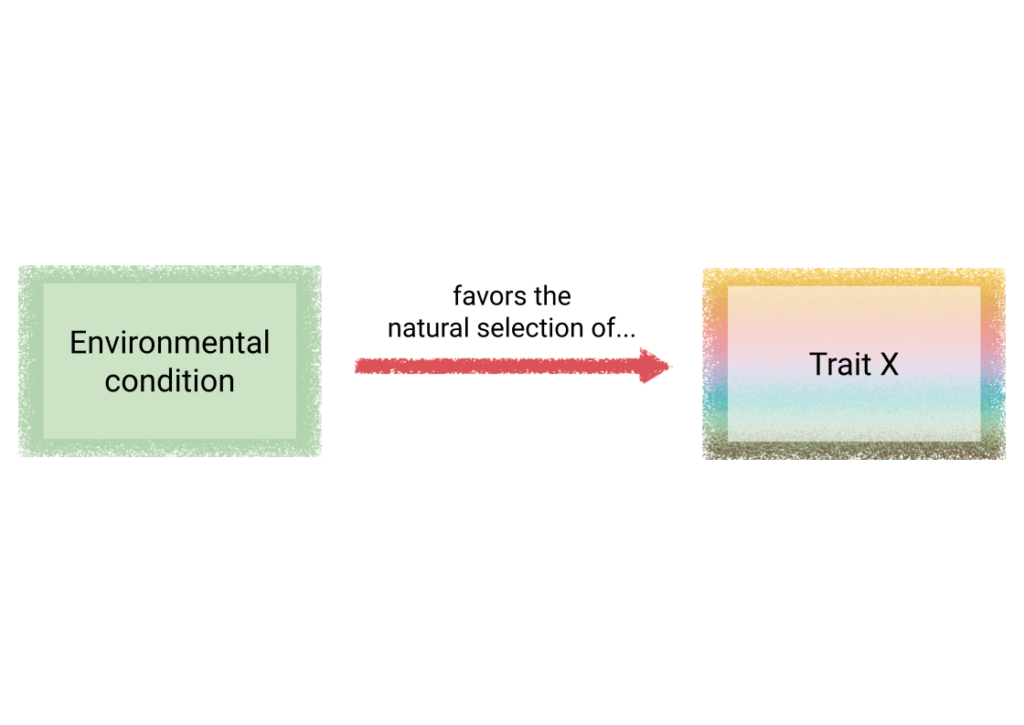
Organisms have many different traits, and these traits often are in interaction with each other.
Body, behavior, brain, genes and other characteristics influence each other. They can enable another trait, favor the development or natural selection of a trait, or prevent the development or natural selection of a trait. For example, certain featurs of the body can make certain behaviors easier to perform than others. Certain genes can favor the development of certain body features and other traits. Conversely, if a behavior has certain advantages to the organism and its frequency increases in the population through natural selection, other traits that enable this behavior may also increase in the population through natural selection.
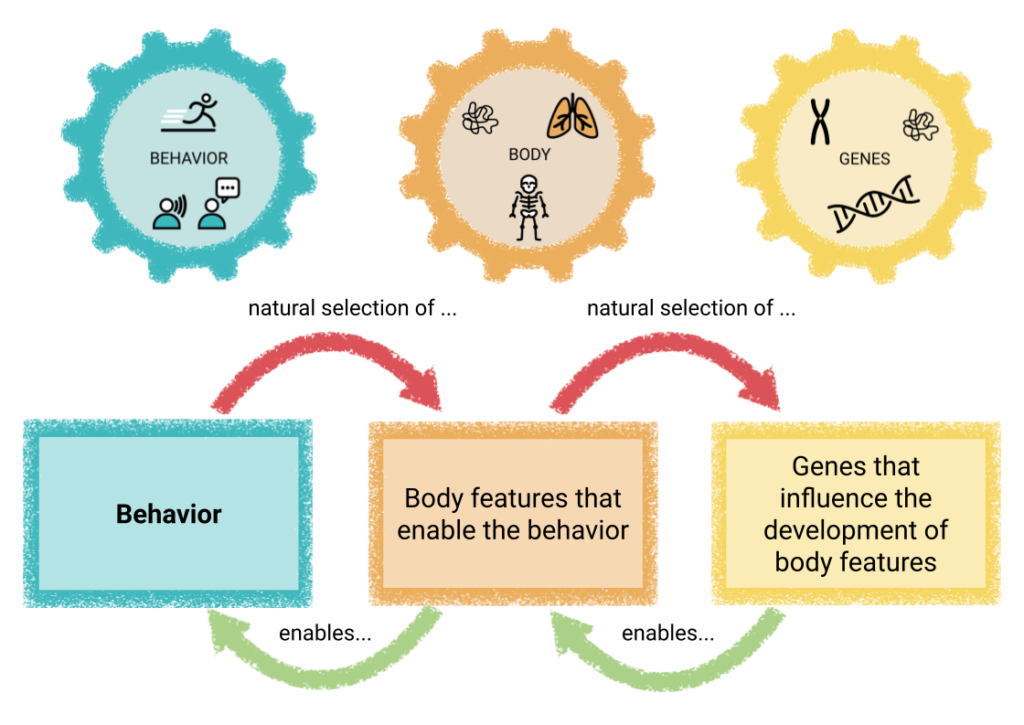
Positive feedback dynamics between environment and organism traits, or between species also often emerge during evolution.
For example, on the one hand conditions in the biotic and abiotic environment lead to the natural selection of a trait in a population. The trait – especially behavioral traits – can in turn cause the environmental conditions to change. This, in turn, may affect the natural selection of the trait, e.g. by selecting the trait even more, etc.
Through such interactions, long lasting interdependent ecological relationships between the environment and living things, or between different species, can emerge.
Such interdependent evolutionary relationships are also called co-evolution.
Example: Domestication
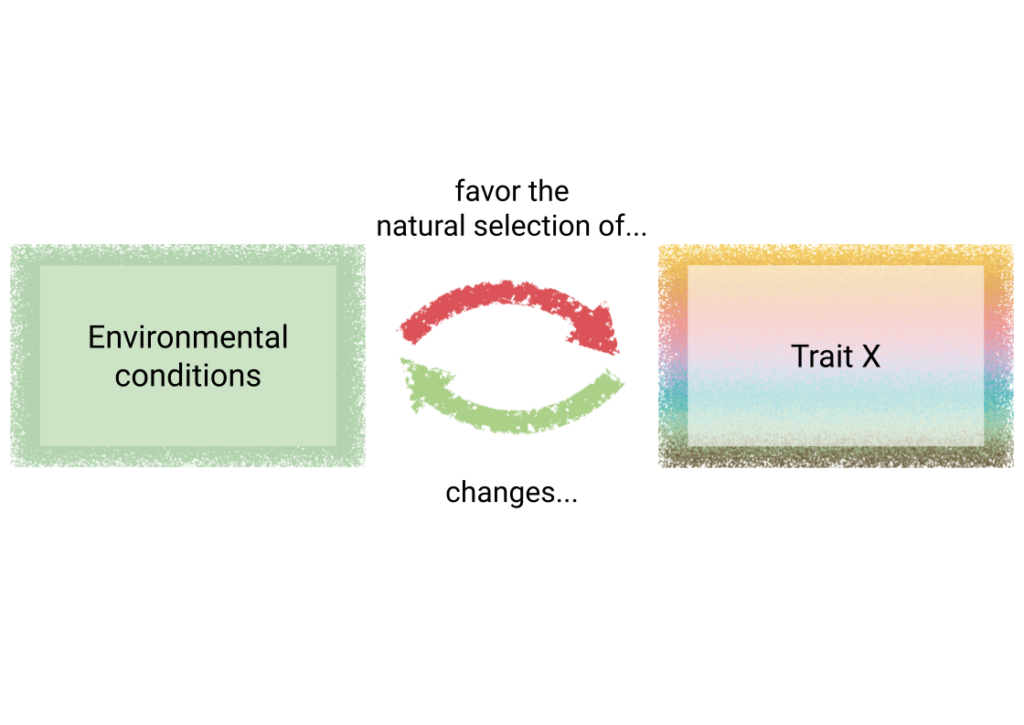
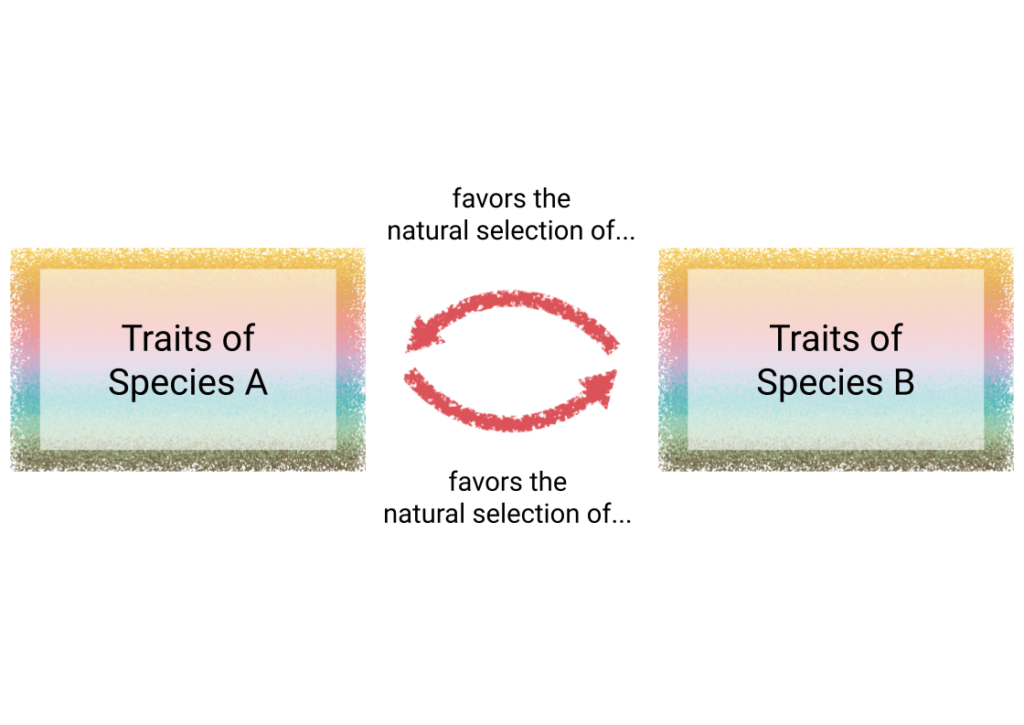
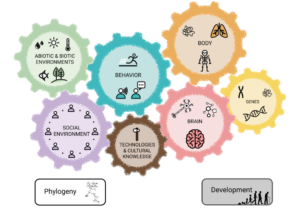
Causal maps on the evolution of human traits
All causal maps on human evolution in one Google slide file

Blackboard materials: Causal maps on human evolution
Materials for constructing causal maps about the evolution of human traits on the blackboard
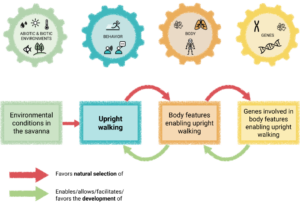
Handout: Introduction to causal maps with the example of upright walking
A handout that introduces students to the causal map to map the evolution and development of traits, with the example of upright walking
References and resources
An article by us about using our causal mapping tools for evolution education:
Hanisch, S. & Eirdosh, D. (2020). Causal mapping as a teaching tool for reflecting on causation in human evolution. Science & Education. https://doi.org/10.1007/s11191-020-00157-z
Here are some example publications that have influenced the development of our causal mapping tool, particularly of evolutionary anthropologists using systems thinking and causal maps as a tool to clarify and discuss complex causality in human evolution:
Antón, S. C., & Josh Snodgrass, J. (2012). Origins and Evolution of Genus Homo. New perspectives. Current Anthropology, 53(S6), S479–S496. https://doi.org/10.1086/667692
Chudek, M., & Henrich, J. (2011). Culture-gene coevolution, norm-psychology and the emergence of human prosociality. Trends in Cognitive Sciences, 15(5), 218–226. https://doi.org/10.1016/j.tics.2011.03.003
Coward, F., & Grove, M. (2011). Beyond the tools: Social innovation and hominin evolution. PaleoAnthropology, 111–129. https://doi.org/10.4207/PA.2011.ART46
Oyama, S., Griffiths, P. E., & Gray, R. D. (2001). Cycles of contingency. Developmental Systems and Evolution. Cambridge, MA, USA: MIT Press.
Whiten, A., & Erdal, D. (2012). The human socio-cognitive niche and its evolutionary origins. Philosophical Transactions of the Royal Society B: Biological Sciences, 367(1599), 2119–2129. https://doi.org/10.1098/rstb.2012.0114
Systems thinking and use of causal diagrams in education:
Cox, M., Steegen, A., & Elen, J. (2018). Using Causal Diagrams to Foster Systems Thinking in Geography Education. International Journal of Designs for Learning, 9(1), 34–48. https://doi.org/10.14434/ijdl.v9i1.22756
Jacobson, M. J. (2001). Problem Solving, Cognition, and Complex Systems: Differences between Experts and Novices. Complexity, 6(3), 41–49. https://doi.org/10.1002/cplx.1027

